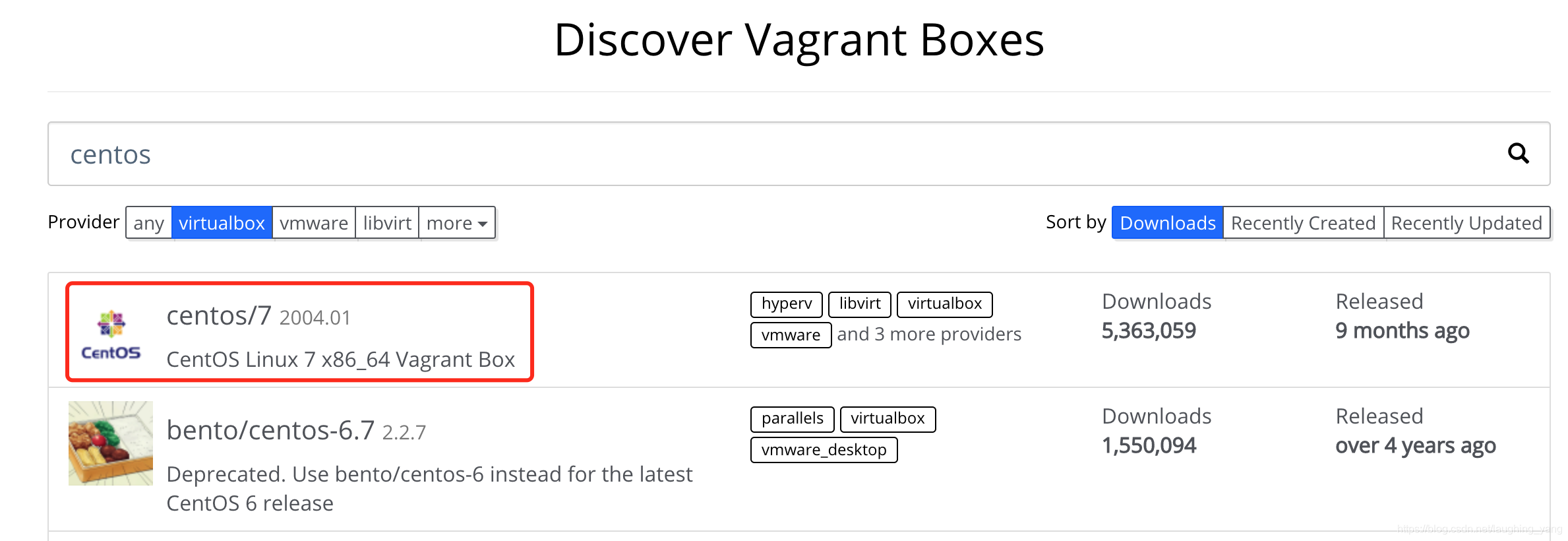virtualBox构建虚拟机 vagrant+virtualBox构建虚拟机的方法
xianbin.yang 人气:0一、介绍
Vagrant是一个构建和管理虚拟机(VirtualBox)的工具。
我的环境:Mac + Vagrant + VirtualBox
网盘下载地址:链接: http://pan.baidu.com/s/1LKacXPQcgh3MjgWiIZ0zhQ 密码: n998
二、安装
VirtualBox: https://www.virtualbox.org/wiki/Downloads
Vagrant: http://downloads.vagrantup.co
三、在线创建虚拟机
1.在官网找到自己想要安装的操作系统:https://app.vagrantup.com/boxes/search

2.点进去,执行命令创建并启动虚拟机:https://app.vagrantup.com/centos/boxes/7

注意:需要单独创建一个目录,在该目录下执行vagrant命令,一个目录对应一个虚拟机。vagrant init会创建一个配置文件Vagrantfile
三、离线创建虚拟机
1.添加
vagrant box add centOs7 /Users/xianbin.yang/Documents/vagrant/centos-7.0-x86_64.box
➜ vagrant vagrant box add centOs7 /Users/xianbin.yang/Documents/vagrant/centos-7.0-x86_64.box ==> box: Box file was not detected as metadata. Adding it directly... ==> box: Adding box 'centOs7' (v0) for provider: box: Unpacking necessary files from: file:///Users/xianbin.yang/Documents/vagrant/centos-7.0-x86_64.box ==> box: Successfully added box 'centOs7' (v0) for 'virtualbox'!
2.初始化
vagrant init centOs7
➜ vagrant vagrant init centOs7 A `Vagrantfile` has been placed in this directory. You are now ready to `vagrant up` your first virtual environment! Please read the comments in the Vagrantfile as well as documentation on `vagrantup.com` for more information on using Vagrant.
3.启动
vagrant up
➜ vagrant vagrant up Bringing machine 'default' up with 'virtualbox' provider... ==> default: Importing base box 'centOs7'... ==> default: Matching MAC address for NAT networking... ==> default: Setting the name of the VM: vagrant_default_1612583375721_1893 ==> default: Clearing any previously set forwarded ports... ==> default: Clearing any previously set network interfaces... ==> default: Preparing network interfaces based on configuration... default: Adapter 1: nat ==> default: Forwarding ports... default: 22 (guest) => 2222 (host) (adapter 1) ==> default: Booting VM... ==> default: Waiting for machine to boot. This may take a few minutes... default: SSH address: 127.0.0.1:2222 default: SSH username: vagrant default: SSH auth method: private key default: default: Vagrant insecure key detected. Vagrant will automatically replace default: this with a newly generated keypair for better security. default: default: Inserting generated public key within guest... default: Removing insecure key from the guest if it's present... default: Key inserted! Disconnecting and reconnecting using new SSH key... ==> default: Machine booted and ready! ==> default: Checking for guest additions in VM... default: The guest additions on this VM do not match the installed version of default: VirtualBox! In most cases this is fine, but in rare cases it can default: prevent things such as shared folders from working properly. If you see default: shared folder errors, please make sure the guest additions within the default: virtual machine match the version of VirtualBox you have installed on default: your host and reload your VM. default: default: Guest Additions Version: 4.3.28 default: VirtualBox Version: 6.1 ==> default: Mounting shared folders... default: /vagrant => /Users/xianbin.yang/Documents/vagrant
四、常用命令
| 命令 | 作用 |
|---|---|
| vagrant box add | 添加box的操作 |
| vagrant init | 初始化box的操作,会生成vagrant的配置文件Vagrantfile |
| vagrant up | 启动本地环境 |
| vagrant ssh | 通过 ssh 登录本地环境所在虚拟机 |
| vagrant halt | 关闭本地环境 |
| vagrant suspend | 暂停本地环境 |
| vagrant resume | 恢复本地环境 |
| vagrant reload | 修改了 Vagrantfile 后,使之生效(相当于先 halt,再 up) |
| vagrant destroy | 彻底移除本地环境 |
| vagrant box list | 显示当前已经添加的box列表 |
| vagrant box remove | 删除相应的box |
| vagrant status | 获取当前虚拟机的状态 |
五、Vagrantfile常用配置
1.配置固定ip、内存、cpu
# -*- mode: ruby -*-
# vi: set ft=ruby :
Vagrant.configure("2") do |config|
config.vm.box = "centOs7"
config.vm.network "private_network", ip: "192.168.33.10"
config.vm.provider "virtualbox" do |vb|
vb.cpus = 4
vb.memory = "8192"
end
end
注意:配置后需要vagrant reload
2.配置root用户和ssh免密
vagrant用户登录:vagrant ssh
设置root密码:sudo passwd root
配置ssh免密:ssh-copy-id root@192.168.33.10
ssh登录:ssh root@192.168.33.10
3.关闭防火墙
检查防火墙状态:systemctl status firewalld
关闭防火墙:systemctl stop firewalld
设置开机禁用防火墙:systemctl disable firewalld.service
参考链接:
https://learn.hashicorp.com/tutorials/vagrant/getting-started-index?in=vagrant/getting-started
加载全部内容